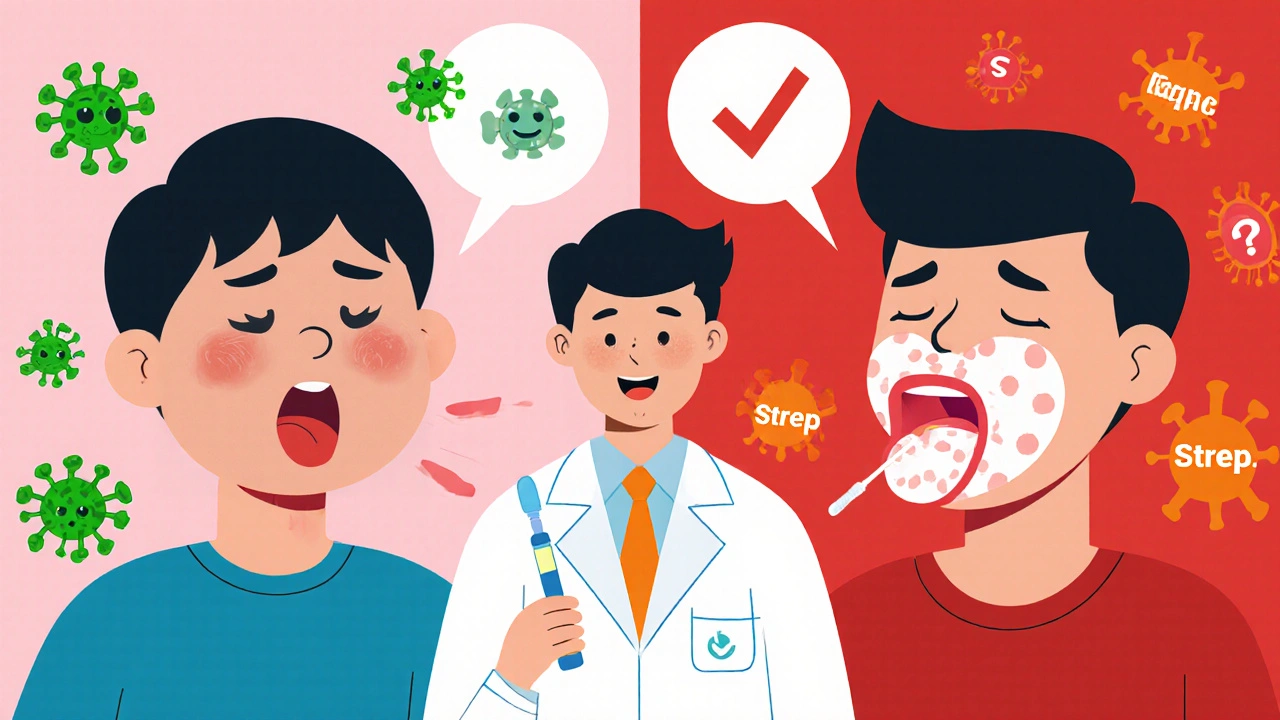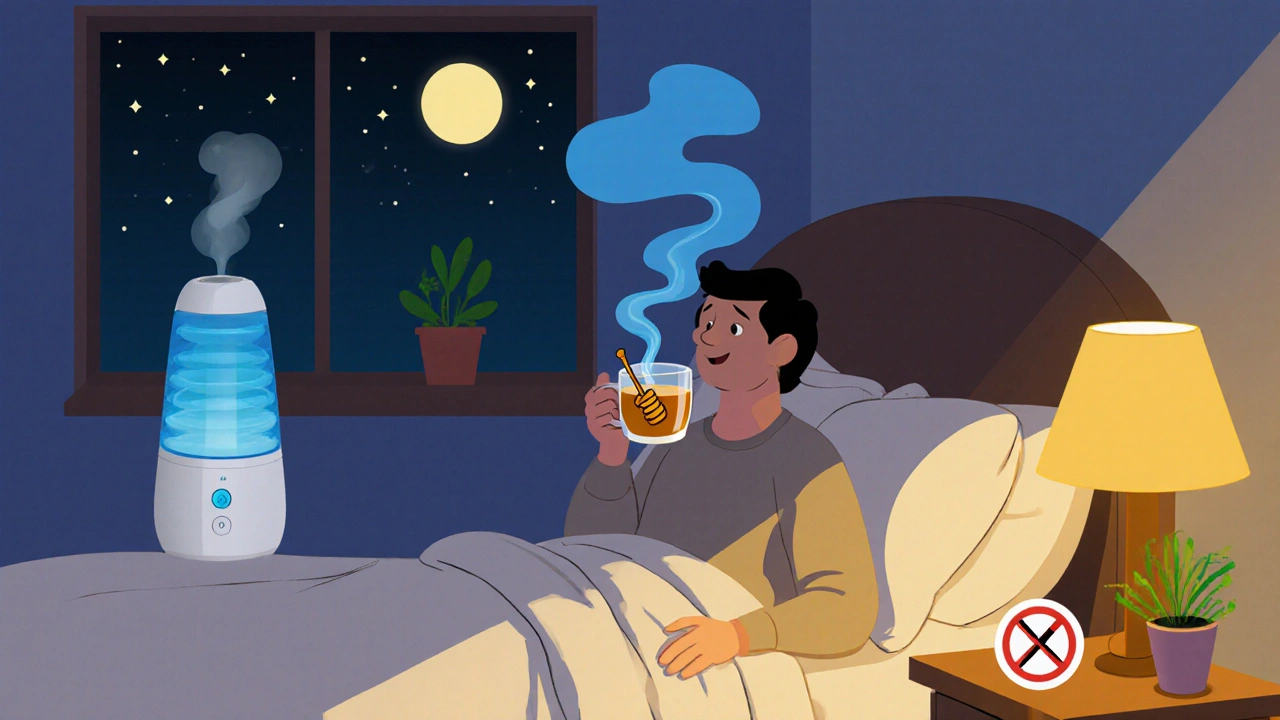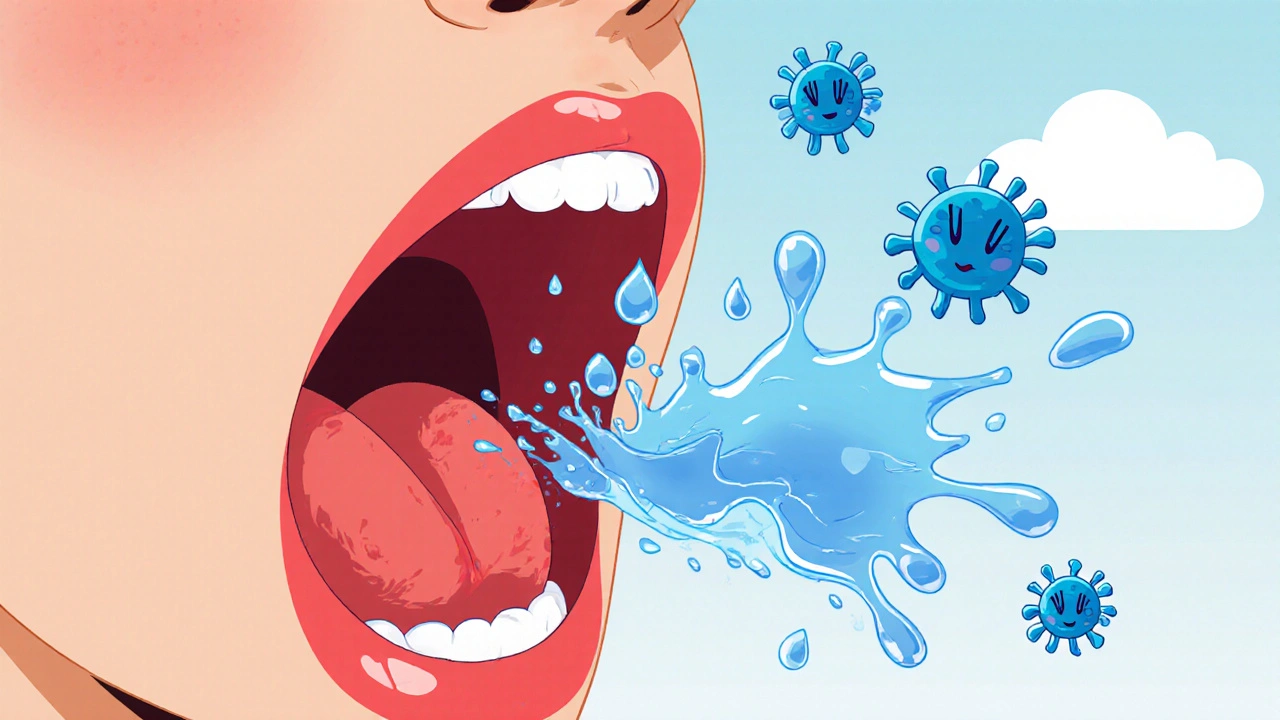When your throat feels scratchy, painful, or irritated, the first thing that comes to mind is often a simple cold or a big gulp of cold water. But a Sore Throat is a symptom that can stem from a surprisingly wide range of triggers. Knowing the root cause matters because it determines whether you need antibiotics, a change in your environment, or just a bit more rest.
Quick Takeaways
- Most sore throats (about 80%) are viral and resolve on their own.
- Bacterial infections, especially Streptococcus, need antibiotics to prevent complications.
- Irritants like dry air, smoking, or acid reflux can cause chronic throat pain without any infection.
- Allergy‑related sore throats often come with itchy eyes and sneezing.
- Seek medical care if pain is severe, lasts more than a week, or is accompanied by fever, rash, or difficulty swallowing.
What Exactly Is a Sore Throat?
A sore throat, medically known as pharyngitis, refers to inflammation of the pharynx-the back of the throat that connects the mouth to the esophagus and larynx. The inflammation can be caused by swelling of the mucous membranes, irritation of the tissue, or infection that brings in immune cells and fluid. That swelling makes swallowing feel painful and can also affect your voice.
Major Categories of Causes
Broadly speaking, sore throats fall into four groups: viral infections, bacterial infections, irritants or environmental factors, and allergic reactions. A fifth, less common group involves systemic issues like gastro‑esophageal reflux disease (GERD) that sends stomach acid up the esophagus and into the throat.
1. Viral Infections
Viruses are the most frequent culprits, accounting for roughly 80 % of acute sore throats. Common viral agents include:
- Influenza virus - causes the classic flu symptoms of fever, body aches, and a dry cough.
- Rhinoviruses - the primary agents of the common cold, often bringing a runny nose and sneezing.
- Coronaviruses, including COVID-19 - may present with sore throat, loss of taste, and fatigue.
- Epstein‑Barr virus - the cause of mononucleosis, which can make the throat feel especially raw and cause swollen lymph nodes.
Because viruses don’t respond to antibiotics, treatment focuses on rest, hydration, and over‑the‑counter pain relievers. Most viral sore throats improve within 5‑7 days.
2. Bacterial Infections
When a bacterium invades the throat, the inflammation tends to be more intense, and the risk of complications rises. The most common bacterial throat infection is Streptococcus pyogenes, which causes “strep throat.” Other bacterial agents include:
- Neisseria gonorrhoeae - rare, usually linked to sexually transmitted infections.
- Corynebacterium diphtheriae - causes diphtheria, a serious disease that can block the airway.
Strep throat often shows a sudden, severe pain, white patches on the tonsils, and a fever above 101 °F (38.3 °C). A rapid antigen test at a clinic can confirm the diagnosis, and a short course of penicillin or amoxicillin clears the infection and prevents rheumatic fever.
3. Irritants & Environmental Factors
Even without germs, your throat can become sore when exposed to harsh conditions:
- Dry air - especially in heated indoor spaces during winter, dries out the mucous membranes.
- Smoking or second‑hand smoke - the chemicals irritate the lining and impair immune defenses.
- Air pollutants like smog or strong fumes - cause chronic irritation.
- Vocal strain - shouting, singing, or prolonged speaking can inflame the muscles.
These causes often lead to a mild, persistent ache that improves once the irritant is removed or humidity is increased.
4. Allergies
Allergic rhinitis (hay fever) isn’t an infection, but the post‑nasal drip it creates can coat the throat with mucus, leading to soreness. Typical allergy signs include itchy eyes, sneezing, and a clear runny nose. Common triggers are pollen, dust mites, pet dander, and mold spores. Antihistamines or nasal steroid sprays usually keep the symptoms in check.
5. Acid Reflux (GERD)
When stomach acid backs up into the esophagus, it can reach the throat and cause a burning sensation known as laryngopharyngeal reflux. People with GERD often report a sour taste in the mouth, hoarseness, and a chronic sore throat that worsens after meals or when lying down. Lifestyle changes-like avoiding spicy foods, not eating late, and elevating the head of the bed-are first‑line strategies, and proton‑pump inhibitors can reduce acid production.

Viral vs. Bacterial Sore Throat: Quick Comparison
| Feature | Viral | Bacterial |
|---|---|---|
| Onset | Gradual, often with cold symptoms | Sudden, severe pain |
| Fever | Low‑grade or absent | High (≥101 °F/38.3 °C) |
| White patches | Rare | Common on tonsils |
| Swollen lymph nodes | Often mild | Prominent, tender |
| Treatment | Supportive care | Antibiotics |
| Typical duration | 5‑7 days | 7‑10 days with antibiotics |
How to Identify the Underlying Cause
Pinpointing the cause starts with a quick self‑check:
- Check the timeline. If pain started yesterday and you have a runny nose, think viral.
- Look for fever. A high fever leans toward bacterial infection.
- Inspect the throat. White or yellow spots suggest bacterial.
- Recall recent exposures. Recent smoke, dry indoor heating, or a flare‑up of known allergies can be the trigger.
- Consider diet. Heartburn after meals points to GERD.
If you’re still unsure, a visit to a primary‑care clinician for a rapid strep test or a throat culture can provide a definitive answer.

When to Seek Professional Help
Most sore throats are harmless, but these red flags merit a doctor’s visit:
- Pain that prevents you from drinking fluids (risk of dehydration).
- Swelling that makes it hard to breathe or swallow.
- Rash, joint pain, or a “strawberry tongue,” which can signal scarlet fever.
- Persistent symptoms longer than 10 days despite home care.
- Repeated episodes in a short period-could indicate chronic reflux or allergies.
Home Care & Prevention Tips
Even if the cause is viral, you can speed up recovery and feel better faster:
- Stay hydrated - warm teas with honey soothe the throat and keep mucus thin.
- Gargle with salt water (½ tsp salt in 8 oz warm water) 2‑3 times a day.
- Use a humidifier in bedroom to combat dry air.
- Avoid irritants: quit smoking, steer clear of strong fragrances.
- Practice good hand hygiene - wash hands for at least 20 seconds to limit viral spread.
If bacterial infection is confirmed, completing the full antibiotic course is crucial, even if you feel better after a few days.
The Bottom Line
Understanding the sore throat causes helps you take the right action-whether that’s simple rest, a change in your environment, or a brief course of antibiotics. Most of the time the pain will fade, but knowing the warning signs ensures you don’t overlook a condition that needs medical attention.
How long does a viral sore throat usually last?
Typical viral sore throats improve within 5‑7 days, though a lingering tickle can persist for a week or two.
Can I treat strep throat with home remedies alone?
Strep throat is a bacterial infection; antibiotics are required to prevent complications. Home remedies can relieve pain but won’t cure the infection.
Is it normal for allergies to cause a sore throat?
Yes. Post‑nasal drip from allergic rhinitis can irritate the throat. Managing the allergies usually eases the soreness.
What lifestyle changes help with GERD‑related sore throat?
Avoid large meals, skip spicy or acidic foods, don’t lie down right after eating, and raise the head of your bed by 6‑8 inches. A weight‑management plan also reduces pressure on the stomach.
When should I see a doctor for a sore throat?
Seek medical care if you have a fever over 101 °F, difficulty swallowing, swelling that affects breathing, a rash, or symptoms lasting more than 10 days.


Kimberly Lloyd
It’s easy to brush off a scratchy throat as just a minor nuisance, but the irritation is actually our body’s polite reminder that something needs attention.
When the lining of the pharynx inflames, it signals that the local environment-whether viral, bacterial, or chemical-has been disturbed.
Taking a moment to note the exact sensations, like sudden sharp pain versus a dull ache, can guide you toward the right remedy.
Staying hydrated, humming a gentle tune, and breathing through the nose are simple habits that give the mucosa a chance to heal.
Remember, each sore throat is a lesson in listening to ourselves, and that listening often leads to quicker recovery.
Lolita Gaela
From a pathophysiological perspective, acute pharyngitis is characterized by mucosal epithelial desquamation accompanied by an influx of neutrophils in bacterial etiologies versus lymphocytic predominance in viral cases.
Rapid antigen detection tests (RADTs) target Group A Streptococcus antigens with >95% specificity, thereby expediting antibiotic stewardship.
In cases of viral etiology, the therapeutic focus shifts to modulating the inflammatory cascade via analgesics such as acetaminophen or ibuprofen, and ensuring optimal hydration to maintain mucociliary clearance.
For allergen‑induced post‑nasal drip, intranasal corticosteroids attenuate eosinophilic inflammation, reducing posterior pharyngeal irritation.
Finally, for gastro‑esophageal reflux‑related laryngopharyngeal reflux, proton‑pump inhibitors mitigate acid exposure, allowing mucosal regeneration.
Giusto Madison
Listen up-you’re not gonna fix a bacterial invasion with just honey and tea, no matter how viral‑centric your grandma’s advice sounds.
Strep throat erupts with that sudden, knife‑like pain and white exudates, and the only proven kill‑switch is a short course of penicillin or amoxicillin.
If you ignore the high fever and let the infection run wild, you’re risking rheumatic fever, which can scar your heart valves for life.
Don’t waste time playing detective; get a rapid strep test done, start the antibiotics, and finish the full prescription even if you feel better after a couple of days.
Skipping the meds is not “tough” it’s reckless, and the payoff is a pain‑free throat and no long‑term complications.
Xavier Lusky
What they don’t tell you is that the pharmaceutical giants profit from keeping you sick, pushing antibiotics like a cash‑cow while hiding cheap herbal alternatives that actually restore throat health.
They’ve got lobbyists in every health board, ensuring that the “standard of care” stays locked into pricey prescription cycles.
If you really want to clear a throat, look into elderberry extract, licorice root, and honey‑cinnamon blends-natural antimicrobials that the industry suppresses.
Don’t let the mainstream narrative dictate your treatment, do your own research and question the motives behind every .pdf they hand you.
Ivan Laney
America’s healthcare system was built on the principle that every citizen deserves access to reliable treatment, and that principle starts with recognizing the true cause of a sore throat.
When a viral infection strikes, the body’s innate immune response does the heavy lifting; no foreign corporation needs to intervene with unnecessary pills.
However, when a bacterial pathogen like Streptococcus pyogenes invades, swift intervention with a proven antibiotic is not just a medical choice-it’s a patriotic duty to protect public health.
The United States has long championed evidence‑based protocols, and the rapid antigen detection test exemplifies the country’s commitment to scientific rigor.
Breathing in polluted air from industrial factories can irritate the pharyngeal mucosa, which is why strict environmental regulations are essential for maintaining a healthy populace.
Similarly, the rising prevalence of GERD is linked to Western dietary habits-excessive processed foods and late‑night meals-that our nation must address through public education.
Allergic rhinitis, another common trigger, can be mitigated by supporting research into hypoallergenic cultivars of grasses and trees, a venture that aligns with America’s agricultural innovation.
When it comes to comfort measures, good old‑fashioned hydration, salt‑water gargles, and humidifiers are cost‑effective solutions that any household can adopt without relying on multinational pharma advertising.
Patriotic citizens should also demand transparency from the Food and Drug Administration, ensuring that new antibiotics are introduced responsibly and not hoarded for profit.
Ultimately, the fight against throat inflammation is a microcosm of the larger battle for national well‑being, and each informed decision contributes to the strength of the republic.
So stand tall, stay informed, and treat your throat with the same vigor you would protect the flag.